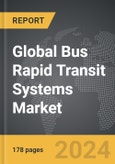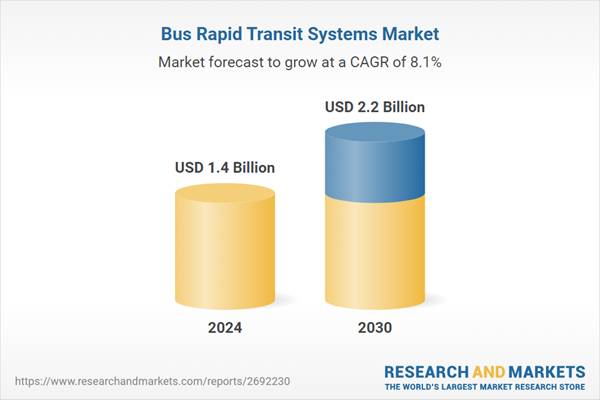The global market for Bus Rapid Transit Systems was valued at US$1.4 Billion in 2024 and is projected to reach US$2.2 Billion by 2030, growing at a CAGR of 8.1% from 2024 to 2030. This comprehensive report provides an in-depth analysis of market trends, drivers, and forecasts, helping you make informed business decisions.
The implementation of BRT systems involves careful planning and design to tailor the system to a city's specific transportation needs. This planning includes service planning, station and bus design, strategic communication approaches, and integration with other transit modes to optimize the passenger experience and system efficiency. Internationally, cities like Istanbul, Johannesburg, Mexico City, and Bogotá have shown that BRT systems can significantly reduce commute times and enhance urban living. This reduction not only boosts productivity and lifestyle flexibility for residents but also contributes to environmental sustainability by lowering greenhouse gas emissions and reducing road incidents, thanks to fewer vehicle kilometers traveled. Additionally, the modern buses used in BRT systems are often equipped with advanced technologies that further decrease local air pollutants.
The expansion of BRT systems is driven by several factors. Quick implementation times make BRT systems ideal for rapidly growing urban areas that need swift solutions to traffic and transit demands. BRT systems also tend to receive substantial public and political support due to their immediate positive impact on transit services, including reductions in travel time and improvements in service quality. Moreover, the introduction of advanced technologies in BRT systems enhances operational efficiency and passenger convenience, which can increase ridership by improving service reliability through features like real-time data tracking and mobile ticketing. As urban populations grow, the scalability of BRT allows for the accommodation of increasing passenger numbers without extensive new infrastructure, making it a practical choice for expanding cities. Additionally, BRT plays a crucial role in promoting social equity by providing affordable, reliable transportation to underserved communities, thereby connecting them with essential city services and opportunities for socio-economic advancement.
Global Bus Rapid Transit Systems Market - Key Trends and Drivers Summarized
Bus Rapid Transit (BRT) systems represent a pivotal innovation in urban transportation, combining the efficiency and capacity of metro systems with the cost-effectiveness and flexibility of bus services. BRT is designed to tackle urban congestion and enhance mobility through several key operational features. These include dedicated lanes that ensure buses are not delayed by general traffic, strategic busway alignment to minimize disruptions, off-board fare collection to expedite boarding processes, and intersection treatments to reduce delays caused by other vehicles. Furthermore, platform-level boarding enhances accessibility and speeds up the boarding and alighting process for all passengers, including those with disabilities. These characteristics collectively improve the speed, reliability, and quality of BRT services, making them an attractive alternative to traditional bus and rail systems.The implementation of BRT systems involves careful planning and design to tailor the system to a city's specific transportation needs. This planning includes service planning, station and bus design, strategic communication approaches, and integration with other transit modes to optimize the passenger experience and system efficiency. Internationally, cities like Istanbul, Johannesburg, Mexico City, and Bogotá have shown that BRT systems can significantly reduce commute times and enhance urban living. This reduction not only boosts productivity and lifestyle flexibility for residents but also contributes to environmental sustainability by lowering greenhouse gas emissions and reducing road incidents, thanks to fewer vehicle kilometers traveled. Additionally, the modern buses used in BRT systems are often equipped with advanced technologies that further decrease local air pollutants.
The expansion of BRT systems is driven by several factors. Quick implementation times make BRT systems ideal for rapidly growing urban areas that need swift solutions to traffic and transit demands. BRT systems also tend to receive substantial public and political support due to their immediate positive impact on transit services, including reductions in travel time and improvements in service quality. Moreover, the introduction of advanced technologies in BRT systems enhances operational efficiency and passenger convenience, which can increase ridership by improving service reliability through features like real-time data tracking and mobile ticketing. As urban populations grow, the scalability of BRT allows for the accommodation of increasing passenger numbers without extensive new infrastructure, making it a practical choice for expanding cities. Additionally, BRT plays a crucial role in promoting social equity by providing affordable, reliable transportation to underserved communities, thereby connecting them with essential city services and opportunities for socio-economic advancement.
Report Scope
The report analyzes the Bus Rapid Transit Systems market, presented in terms of market value (USD). The analysis covers the key segments and geographic regions outlined below.Segments
Bus Type (Articulated, Standard, Other Types); Service Type (Closed BRT System, Open BRT System, Hybrid BRT System); Application (Urban Territories, Other Territories).Geographic Regions/Countries
World; United States; Canada; Japan; China; Europe (France; Germany; Italy; United Kingdom; Spain; Russia; and Rest of Europe); Asia-Pacific (Australia; India; South Korea; and Rest of Asia-Pacific); Latin America (Argentina; Brazil; Mexico; and Rest of Latin America); Middle East (Iran; Israel; Saudi Arabia; United Arab Emirates; and Rest of Middle East); and Africa.Key Insights:
- Market Growth: Understand the significant growth trajectory of the Articulated Bus segment, which is expected to reach US$1.1 Billion by 2030 with a CAGR of a 8.8%. The Standard Bus segment is also set to grow at 7% CAGR over the analysis period.
- Regional Analysis: Gain insights into the U.S. market, valued at $350.3 Million in 2024, and China, forecasted to grow at an impressive 11.7% CAGR to reach $526.3 Million by 2030. Discover growth trends in other key regions, including Japan, Canada, Germany, and the Asia-Pacific.
Why You Should Buy This Report:
- Detailed Market Analysis: Access a thorough analysis of the Global Bus Rapid Transit Systems Market, covering all major geographic regions and market segments.
- Competitive Insights: Get an overview of the competitive landscape, including the market presence of major players across different geographies.
- Future Trends and Drivers: Understand the key trends and drivers shaping the future of the Global Bus Rapid Transit Systems Market.
- Actionable Insights: Benefit from actionable insights that can help you identify new revenue opportunities and make strategic business decisions.
Key Questions Answered:
- How is the Global Bus Rapid Transit Systems Market expected to evolve by 2030?
- What are the main drivers and restraints affecting the market?
- Which market segments will grow the most over the forecast period?
- How will market shares for different regions and segments change by 2030?
- Who are the leading players in the market, and what are their prospects?
Report Features:
- Comprehensive Market Data: Independent analysis of annual sales and market forecasts in US$ Million from 2024 to 2030.
- In-Depth Regional Analysis: Detailed insights into key markets, including the U.S., China, Japan, Canada, Europe, Asia-Pacific, Latin America, Middle East, and Africa.
- Company Profiles: Coverage of players such as Amcor Ltd., Anhui Ankai Automobile Co., Ltd., Ashok Leyland Ltd., Blue Bird Corporation, Daimler AG and more.
- Complimentary Updates: Receive free report updates for one year to keep you informed of the latest market developments.
Some of the 33 companies featured in this Bus Rapid Transit Systems market report include:
- Amcor Ltd.
- Anhui Ankai Automobile Co., Ltd.
- Ashok Leyland Ltd.
- Blue Bird Corporation
- Daimler AG
- Designline Bus Pacific Ltd.
- GILLIG LLC
- Graphic Packaging Holding Company
- Mayr-Melnhof Karton AG
- NABI Bus, LLC
- New Flyer Industries, Inc.
- Nova Bus, Inc.
- Optare Group Ltd.
- Scania AB
- Tata Motors Ltd.
- Volvo Bus Corporation
Table of Contents
I. METHODOLOGYII. EXECUTIVE SUMMARY2. FOCUS ON SELECT PLAYERSIII. MARKET ANALYSISCANADAITALYSPAINRUSSIAREST OF EUROPESOUTH KOREAREST OF ASIA-PACIFICARGENTINABRAZILMEXICOREST OF LATIN AMERICAIRANISRAELSAUDI ARABIAUNITED ARAB EMIRATESREST OF MIDDLE EASTIV. COMPETITION
1. MARKET OVERVIEW
3. MARKET TRENDS & DRIVERS
4. GLOBAL MARKET PERSPECTIVE
UNITED STATES
JAPAN
CHINA
EUROPE
FRANCE
GERMANY
UNITED KINGDOM
ASIA-PACIFIC
AUSTRALIA
INDIA
LATIN AMERICA
MIDDLE EAST
AFRICA
Companies Mentioned (Partial List)
A selection of companies mentioned in this report includes, but is not limited to:
- Amcor Ltd.
- Anhui Ankai Automobile Co., Ltd.
- Ashok Leyland Ltd.
- Blue Bird Corporation
- Daimler AG
- Designline Bus Pacific Ltd.
- GILLIG LLC
- Graphic Packaging Holding Company
- Mayr-Melnhof Karton AG
- NABI Bus, LLC
- New Flyer Industries, Inc.
- Nova Bus, Inc.
- Optare Group Ltd.
- Scania AB
- Tata Motors Ltd.
- Volvo Bus Corporation
Table Information
| Report Attribute | Details |
|---|---|
| No. of Pages | 178 |
| Published | April 2025 |
| Forecast Period | 2024 - 2030 |
| Estimated Market Value ( USD | $ 1.4 Billion |
| Forecasted Market Value ( USD | $ 2.2 Billion |
| Compound Annual Growth Rate | 8.1% |
| Regions Covered | Global |









